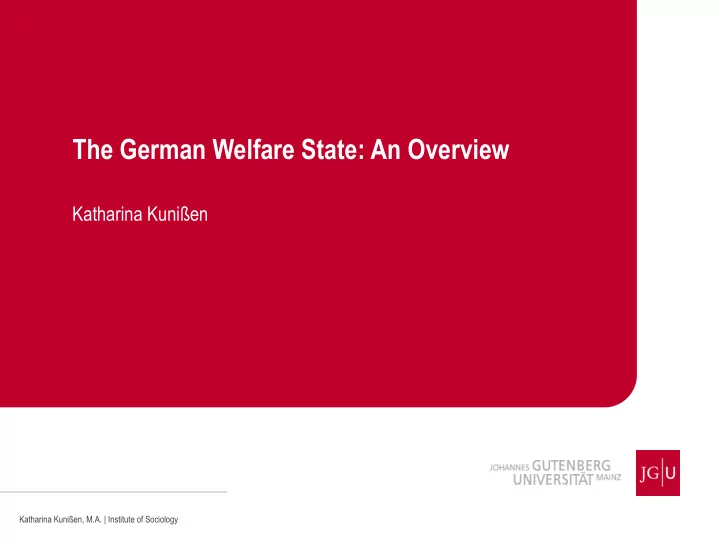

The German Welfare State: An Overview Katharina Kunißen Katharina Kunißen, M.A. | Institute of Sociology
Agenda 1 Origins of the German Welfare State 2 The Contemporary German Welfare State 3 Areas of the German Welfare State 3.1 Unemployment Insurance (“Arbeitslosenversicherung”) 3.2 Health Insurance (“Krankenversicherung”) 3.3 Disability Insurance (“Berufsunfähigkeitsversicherung”) 3.4 Old Age: Pensions (“Rentenversicherung”) 3.5 Old Age: Long-Term Care (“Pflegeversicherung”) 4 Current Challenges of the German Welfare State 5 Summary and Discussion 2 Katharina Kunißen, M.A. | Institute of Sociology
1 Origins of the German Welfare State: The Bismarckian System à 1883: Health Insurance Bill à 1884: Accident Insurance Bill à 1889: Old Age and Disability Insurance Bill à 1927: Unemployment Insurance Bill 3 Katharina Kunißen, M.A. | Institute of Sociology
1 Origins of the German Welfare State: The Bismarckian System the alternative: Bismarckian System Beveridge System Entitlement contribution (employment) citizenship Financing income à social insurance taxes Insurer occupational state Benefits based on previous income lump sum 4 Katharina Kunißen, M.A. | Institute of Sociology
2 The Contemporary German Welfare State à 1883: Health Insurance Bill à 1884: Accident Insurance Bill à 1889: Old Age and Disability Insurance Bill à 1927: Unemployment Insurance Bill à 1995: Long-Term Care Insurance Bill 5 Katharina Kunißen, M.A. | Institute of Sociology
2 The Contemporary German Welfare State: The Conservative System (… plus some liberal and social democratic elements…) “earnings-related” “replication of inequality“ “preservation of status“ “traditional familyhood“ “subsidiarity“ “additional private insurance schemes” 6 Katharina Kunißen, M.A. | Institute of Sociology
3 Areas of the Welfare State 7 Katharina Kunißen, M.A. | Institute of Sociology
3.1 Unemployment Insurance Unemployment benefit I Condition Having worked 12 months in the last 2 years Benefit About 60% of net income Financed mainly by individual & employer Unemployment benefit II ”Hartz IV“ Condition Not/ no longer entitled to benefit I Benefit Fixed rate + housing + additional needs Financed by State/ taxes 8 Katharina Kunißen, M.A. | Institute of Sociology
3.2 Health Insurance 1 Public health insurance Benefit Covers most medical costs Financed mainly by individual & employer 2 Private health insurance (self-employed, state servant, voluntary choice) Benefit Covers most medical costs Financed mainly by individual (self-employed) individual & employer (state servants) 9 Katharina Kunißen, M.A. | Institute of Sociology
3.3 Disability Insurance 1 During the first 6 weeks Condition Previous employment Benefit Usual wage Financed by employer 2 More than 6 weeks, less than 78 weeks Condition Previous employment Benefit Max. 90% of net income Financed by Health insurance 3 Indefinite inability to work Benefit Fixed rate + housing + additional needs (“Sozialhilfe”) Financed by State/ taxes 10 Katharina Kunißen, M.A. | Institute of Sociology
3.4 Old Age: Pensions 1 Regular pension Condition Employment and age (65 years/ 67 years) Benefit Based on length of employment + income + weights Financed mainly by individual & employer 2 Not eligible for regular pension Benefit Fixed rate + housing + additional needs (“Sozialhilfe”) Financed by State/ taxes 11 Katharina Kunißen, M.A. | Institute of Sociology
3.5 Old Age: Long-Term Care 1 Regular long-term care insurance Benefit Necessary costs Financed mainly by individual & employer 2 Not eligible for regular long-term care Benefit Necessary costs Financed by State/ taxes 12 Katharina Kunißen, M.A. | Institute of Sociology
4 Current Challenges of the German Welfare State versus 13 Katharina Kunißen, M.A. | Institute of Sociology
5 Summary and Discussion Most benefits provided by German welfare state are financed through contributions by employers and employees . If a person is unable to contribute to the insurance schemes, the state ensures a basic income (“Sozialhilfe”). Demographic change and longevity increase the need for private (additional) insurance schemes. Additional (active) measures include e.g. active labour market policies . 14 Katharina Kunißen, M.A. | Institute of Sociology
Bibliography All pictures are licensed under the the Creative Commons Zero (CC0) license Castles, Francis G./ Leibfried, Stephan/ Lewis, Jane/ Obinger, Herbert/ Pierson, Christopher (Eds.) (2010): The Oxford Handbook of the Welfare State . Oxford: University Press. Esping-Andersen, G. (1990). The three worlds of welfare capitalism . Cambridge, UK: Polity Press. Schmidt, Manfred G./ Ostheim, Tobias/ Siegel, Nico A./ Zohlnhöfer, Reimut (Eds.) (2007): Der Wohlfahrtsstaat. Eine Einführung in den historischen und internationalen Vergleich . Springer: VS Verlag. Sozialgesetzbuch der Bundesrepublik Deutschland . 46 th edition. 15 Katharina Kunißen, M.A. | Institute of Sociology
Recommend
More recommend